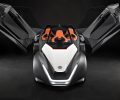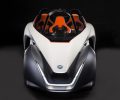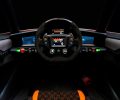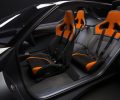https://youtube.com/watch?v=oLlbGSOogUQ%3Frel%3D0
BRINGS CUTTING EDGE INTELLIGENT MOBILITY
- Advanced full-electric battery powertrain with stunning performance and dynamic handling
- Zero-emission driving fun with central driving position and two passenger seats behind
RIO DE JANEIRO, Brazil – Nissan Motor Co., Ltd. today unveiled the working prototype of its futuristic Nissan BladeGlider vehicle, combining zero-emissions with high-performance in a revolutionary sports car design.
The vehicles, developed from concept cars first shown at the Tokyo Auto Show in 2013, have arrived in Brazil to symbolize future technologies that will combine Intelligent Mobility, environmentally friendly impact and sports-car driving capabilities.
Carlos Ghosn, president and chief executive officer, Nissan Motor Co., Ltd. said: “These prototypes epitomize Nissan’s drive to expand its Intelligent Mobility philosophy, where driving pleasure combines with environmental responsibility. Nissan believes that enthusiasts should look forward to a zero emission future and Nissan BladeGlider is a perfect demonstration of that. It’s the electric vehicle for car lovers.”
The debut of the Nissan Bladeglider prototypes forms part of Nissan’s on-going commitment to the development of zero-emission vehicles and new automotive technologies including autonomous drive systems and connectivity. Nissan already sells the world’s highest-volume zero-emission car, the LEAF, and is pioneering Intelligent Mobility systems that will be deployed in a range of vehicles over coming years.
With the Nissan Bladeglider, Nissan’s vision was for an agile, efficient EV that would provide new dimensions of driving fun and excitement – a car that would “glide,” thanks to the near-silent performance of its electric powertrain and aerodynamic shape.
After two years of work on design, engineering and development, Nissan BladeGlider has evolved further into an exciting, real-life study into the potential of advanced EV performance. Nissan BladeGlider epitomizes Intelligent Mobility, a philosophy to make its cars more exciting by redefining how they are driven, powered and integrated into society.
The demonstration models feature an advanced chassis configuration with a narrow front track and wider rear track for optimum aerodynamic efficiency and handling stability.
High-waisted, rear-hinged dihedral doors provide a dramatic entry and exit to the cabin. The open roof of Nissan BladeGlider is reinforced with an integrated roll-over protection structure, providing the exhilaration of an open-topped race car with the safety of a coupe.
Wheel-mounted controls for Nissan BladeGlider’s systems feed into an advanced display showing speed, state of battery charge, regeneration mode and torque map. Flanking the central display are two screens, with the images of rear-view cameras mounted just behind the front wheels. An alternative to door-mounted mirrors, this dual screen design improves the aerodynamic efficiency of Nissan BladeGlider. The driver sits in arrowhead formation slightly in front of two passengers, who enjoy extended legroom. The view for all occupants is panoramic thanks to the seamless cockpit windscreen.
Power is 100 percent electric, with exceptional powertrain performance delivered by Nissan’s technical partner for the Nissan BladeGlider project, UK-based Williams Advanced Engineering. Maximum speed of the demonstration models is in excess of 190km/h*, with 0-100km/h taking less than five seconds*. The rear wheels’ drive is provided by two 130kW electric motors – one for each wheel.
The system features torque vectoring, controlling the torque delivered to the driven wheels, improving the handling even further. With torque vectoring, if the car starts to understeer, it automatically sends more torque to the outside wheel to restore the handling balance.
Designed to add to the driving experience rather than govern it, the torque vectoring system has three settings: off, agile and drift mode.
Power is supplied by a high performance, five module lithium-ion 220kW battery. Bespoke cooling systems have been developed for both the battery and the motors.
The interior of the Nissan BladeGlider reflects the vehicles’ sporting intentions, with four point safety harnesses for each occupant. The seats offer exceptional support to sides and legs of the driver and passengers. The seats are trimmed in a highly tactile blend of fabric and epoxy resin coating, resulting in a tough and grippy material that has the effect of comfortably securing occupants in place.
There are two color trims – Cyber Green and Stealth Orange. These colors are used for the upper portions of the seat back and framed with a silver reflective material to create an eye-catching, sporty look. The base of the seats is in black, patterned material, with a band of green and orange trim framing the cushion.
Two Nissan BladeGliders will be presented in Rio de Janeiro in August. One will be on static display in Rio while the second will be offering dynamic rides to media and VIPs.
| Nissan BladeGlider key statistics | |
| Top speed | >190km/h (115mph)* |
| Acceleration 0-100km/h (62mph) | < 5 seconds* |
| Power | 200kW (268 hp) |
| Torque | 707Nm |
| Weight | 1300kg |
| Length | 4300mm |
| Width | 1850mm |
| Height | 1300mm |
| Wheelbase | 2800mm |
*Figures recorded by Williams Advanced Engineering
WILLIAMS ADVANCED ENGINEERING CONTINUES NISSAN PARTNERSHIP WITH BLADEGLIDER COLLABORATION
Nissan unveiled its ground-breaking BladeGlider prototype today in Rio de Janeiro, Brazil, with Williams Advanced Engineering playing an important role in the car’s creation as Nissan’s technical partner.
First seen as a concept car at the 2013 Tokyo Motor Show, Nissan utilised Williams Advanced Engineering’s expertise in electric powertrains, aerodynamics and chassis dynamics to build two prototypes at the Williams factory in Grove, Oxfordshire. One will be on static display in Rio de Janeiro at the Olympic Park, while the second will be used in Rio for dynamic rides to select media and VIPs.
The demonstration vehicles feature an advanced three seat conceptual configuration with a narrow front track and wider rear track for enhanced aerodynamic efficiency and chassis dynamics. The vehicle layout also features a very focused central driving position which further accentuates the sense of driver involvement. The fully electric concept, which was designed as a glimpse into the future of electric vehicles (EVs), features exceptional performance delivered by Williams Advanced Engineering’s battery and motor technology with a top speed in excess of 190km/h, with 0-100km/h taking less than five seconds.
BladeGlider further builds on a successful collaborative relationship between Williams Advanced Engineering and Nissan on a number of previous projects.
Speaking about the project Craig Wilson, Managing Director of Williams Advanced Engineering, said; “At Williams Advanced Engineering we like to use our expertise in automotive engineering to help customers push the boundaries with their new products. This is exactly what Nissan is doing with BladeGlider, a real-life study that shows the potential of EV cars in terms of styling and performance. We were delighted to be involved with the project and Nissan’s forward-thinking approach to EVs.”
Daniele Schillaci, Executive Vice President, Sales and Marketing Nissan Motor Co. Ltd., added; “Thanks to the partnership with Williams Advanced Engineering on the BladeGlider project, Nissan has been able to explore the potential for a high performance EV under the philosophy of Nissan Intelligent Mobility. With BladeGlider, we want to challenge the public’s expectations of what an EV could look like and the performance it can deliver.”








